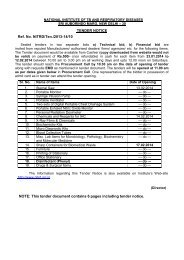The Indian Journal of Tuberculosis - LRS Institute of Tuberculosis ...
The Indian Journal of Tuberculosis - LRS Institute of Tuberculosis ...
The Indian Journal of Tuberculosis - LRS Institute of Tuberculosis ...
You also want an ePaper? Increase the reach of your titles
YUMPU automatically turns print PDFs into web optimized ePapers that Google loves.
168<br />
SUMMARIES OF PAPERS<br />
Changing pr<strong>of</strong>ile <strong>of</strong> lung cancers presentation<br />
in Govt. General Hospital, Chennai<br />
R. Prabhakaran, V. Sundar, B. Rajagopalan, D.<br />
Ranganathan, and R. Athurunnisa Begum.<br />
Aim: To study the changing pr<strong>of</strong>ile <strong>of</strong> lung cancers<br />
in year 1995 and year 2005.<br />
Method: In the combined retrospective and<br />
prospective study, cases <strong>of</strong> lung cancers were<br />
scanned for distinctive (clinic pathological features,<br />
histropathological types and biological behaviour <strong>of</strong><br />
the tumour.<br />
Results: Total 83 diagnosed cases <strong>of</strong> lung cancer<br />
in 1995 were analysed in details. Male female<br />
ratio was 5.91 : 1, age range was from 35 to 87<br />
years and maximum number <strong>of</strong> patients were<br />
between 46-64 years. Most common<br />
histopathological type in male was squamous cell<br />
carcinoma; most common histopathological type in<br />
females was adeno-carcinoma. Most common<br />
respiratory symptoms were cough 83.13%,<br />
hemoptysis 37.34% and chest pain 73.49%. Out <strong>of</strong><br />
83 patients, 61 patients were smokers, 22 were nonsmokers.<br />
Most common cell type in smokers was<br />
squamous cell carcinoma followed by adenocarcinoma.<br />
Among non-smokers most common cell<br />
type was adeno carcinoma.<br />
All small cell carcinoma patients were<br />
smokers. 61.44% were having clubbing. Commonest<br />
presentation in chest radiograph was mass lesion<br />
(75.90%). Sputum cytology positive 7.22%, post<br />
FOB sputum cytology positive 15.66%, CT guided<br />
biopsy positive 85.36%, FOB guided biopsy positive<br />
74.99%, USG guided biopsy positive 100% were<br />
noted.<br />
This pattern has a few important differences<br />
when compared with recent 1 year study conducted<br />
in the same hospital in 2004 - 2005.<br />
Conclusion: <strong>The</strong>re is an increasing occurrence <strong>of</strong><br />
lung cancer with a few definite changing patterns.<br />
Improved diagnostic method may be responsible.<br />
Smoking is the commonest etiological factor.<br />
Although squamous cell carcinoma is commonest<br />
type but adeno carcinoma is also not uncommon.<br />
Statistical analysis <strong>of</strong> risk factors with PFT<br />
abnormalities among traffic police personnel<br />
using a new risk scoring system<br />
A. Chitrakumar, K. Jagannath and R.<br />
Altharunnisa Begum<br />
Objective: Identifying pulmonary function<br />
abnormalities among traffic police personnel serving<br />
in the city <strong>of</strong> Chennai and correlating the same with<br />
their respiratory symptoms and other risk factors as<br />
evaluated with a new scoring system introduced by<br />
us.<br />
Methodology: All the eligible traffic police personnel<br />
were subjected to a respiratory questionnaire<br />
prepared specifically for the study and subsequently<br />
measurement <strong>of</strong> BP, Oxygen saturation and PFT by<br />
spirometer were done. All <strong>of</strong> them had a MMR. In<br />
all among 825 traffic police personnel screened, 768<br />
were found eligible for inclusion in the study.<br />
Findings: Pulmonary function abnormalities<br />
correlated well with persons with respiratory<br />
symptoms, age <strong>of</strong> the individual, smoking habit and<br />
duration <strong>of</strong> service in polluted environment.<br />
<strong>The</strong> multiple logistic regression analysis<br />
revealed that respiratory symptoms were found to<br />
be significant independent variables contributing very<br />
significantly for abnormal PFT variables, i.e. FEVI<br />
(or 1.79; p0.02), PEFR (or 1.58; p0.04), FEF 25-75<br />
(or 2.40; p0.0001)<br />
<strong>The</strong> new computer based scoring system<br />
on risk factors clearly predicts that increase in risk<br />
score is positively associated with increased<br />
proportion <strong>of</strong> PFT abnormalities in high risk groups.<br />
Conclusion: <strong>The</strong> newly introduced risk scoring<br />
system will be quite useful in identifying or<br />
predicting pulmonary function abnormalities<br />
among respiratory symptomatics with other<br />
confounding variables. Among persons exposed<br />
to environmental pollution, evaluation <strong>of</strong> small<br />
airway function may help us to identify their<br />
disability at the earliest.<br />
<strong>Indian</strong> <strong>Journal</strong> <strong>of</strong> <strong>Tuberculosis</strong>
















